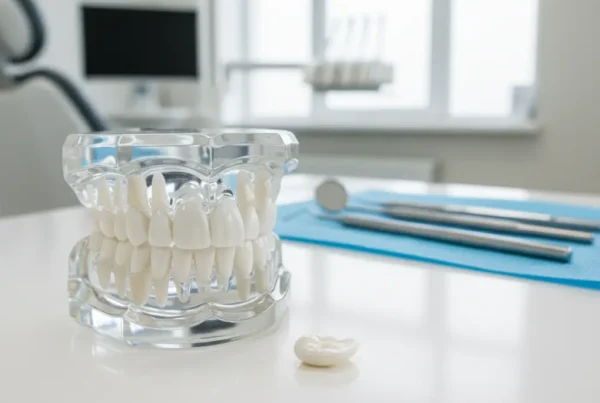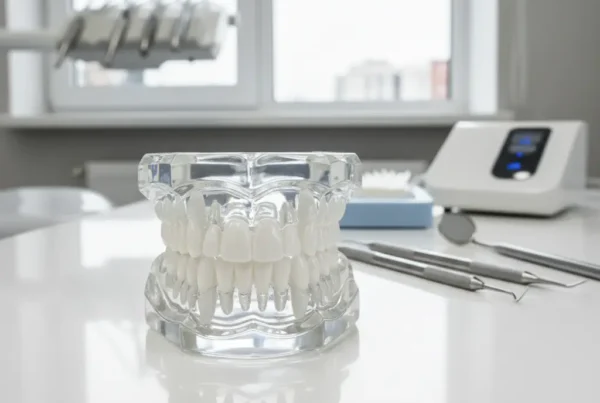Dental veneers offer two main types with distinct advantages: porcelain and composite materials. Porcelain veneers last 15 to 20 years with superior stain resistance, while composite veneers provide affordable, repairable options. Both types protect weakened teeth while correcting aesthetic concerns like stains, chips, and gaps. Costs vary significantly based on material choice, with porcelain commanding higher prices but offering greater longevity.
The realm of dental veneers presents an opportunity for individuals to correct imperfections and attain a harmonious smile. Dr. Nazita Gaff, a fourth generation dentist at Laguna Heights Dental, has witnessed how veneer application transforms both appearance and confidence for patients seeking comprehensive smile makeovers.
In its essence, veneer application is a custom process designed to address a variety of dental concerns through a choice of materials. Each material comes with its benefits tied to cost considerations that patients must carefully evaluate. The types of veneers primarily include porcelain and composite, which serve distinct purposes in cosmetic dentistry.
Porcelain, known for its durability and natural look, is ideal for those seeking a long term solution with minimal maintenance. Composite, however, is favored for its affordability and the ease with which it can be repaired or modified. This makes it suitable for individuals looking for a cost effective and convenient option.
The advantages of veneers go beyond aesthetics in ways many patients don’t initially realize. They provide a protective layer to weakened teeth, potentially preventing further damage, and can mask persistent stains resistant to conventional whitening methods. Thus, they offer a dual function by not only improving the visual appeal of teeth but also contributing to their structural integrity.
Introduction
The allure of dental veneers lies in their dual capacity to enhance dental form and function. These thin, custom made coverings are adept at correcting visual imperfections and simultaneously providing structural support to the teeth. They represent an investment in both aesthetics and oral health, addressing a spectrum of dental issues with finesse.
One aspect of veneers is the choice of material, with porcelain and composite being the two primary options. Porcelain veneers are celebrated for their strength and seamless blending with natural teeth, often recommended for their resistance to stains and longevity. Conversely, composite veneers are crafted chairside, offering a quicker and often less expensive alternative.
Another dimension of veneers is their protective quality that many patients overlook initially. They act as a barrier against further damage to teeth that are already weak or compromised. For example, a tooth with a minor crack can be shielded from the stress of chewing, potentially averting a more serious fracture.
Lastly, considering veneers as a dental solution involves understanding the associated costs. Porcelain veneers tend to come with a higher price tag due to the material’s advantages, such as durability and a life like appearance. Composite veneers, while less costly upfront, may require more frequent maintenance or replacement, balancing immediate affordability with long term investment considerations.
Understanding Veneer Varieties
Choosing the right type of veneers is crucial, as it significantly affects the results of the dental procedure. This decision should be based on a clear understanding of the differences between the two main types, with each offering distinct benefits geared toward specific dental requirements and patient preferences.
Porcelain veneers are recognized for their durability and their ability to mimic the appearance of natural enamel. Their resilience against stains and chipping appeals to individuals desiring a permanent enhancement to their smile with minimal maintenance needs. In real world terms, this means opting for porcelain when a major transformation is desired that won’t demand frequent touch ups.
On the other hand, composite veneers offer an accessible alternative that appeals to both the budget conscious and those seeking quicker treatment timelines. Their application process, which typically involves directly sculpting the material onto the teeth, allows for a more immediate fix. This makes composite veneers an attractive option for patients who need minor cosmetic changes or who prefer the flexibility of treatment.
Dismantling Veneer Myths
Dispelling myths about dental veneers is essential to understand their true value and ease of upkeep. Three principal misconceptions exist which can skew the perception of veneers and their place in dental care.
The myth that veneers are high maintenance can deter those who could greatly benefit from them. In reality, maintaining veneers involves a similar hygiene routine to caring for natural teeth. This means regular brushing and flossing will suffice to keep veneers in good condition, just as one would care for natural teeth.
There’s a mistaken belief that getting veneers is an invasive and damaging process to the teeth. Modern dentistry has evolved to place a strong emphasis on conservation, with techniques that preserve as much of the healthy tooth structure as possible. For example, the preparation stage for veneers often requires only minimal adjustment to the natural tooth.
The idea that veneers are prone to damage and therefore unreliable is another fallacy:
- Properly crafted veneers withstand normal chewing forces and daily use
- Quality materials resist staining and maintain appearance over time
- Professional placement minimizes risk of chipping or detachment
- Regular dental checkups ensure early detection of any issues
- Patients can eat, drink, and maintain normal routines confidently
With proper care, veneers are remarkably durable and can withstand the demands of daily use. Patients can go about their usual routines with confidence, knowing that veneers are built to last when appropriately crafted and placed by skilled dental professionals.
Appreciating Veneer Longevity
Understanding the longevity of dental veneers is key to appreciating their value as a long term dental solution. This lifespan is influenced by several factors which, when considered together, demonstrate the lasting benefits of veneers beyond their immediate cosmetic appeal.
Porcelain veneers are known for their exceptional durability that sets them apart from other cosmetic options. Their robust construction means they can last for many years, often over a decade, without requiring replacement. This makes them an ideal choice for those seeking a permanent dental correction that can withstand the rigors of daily life.
The ease of maintenance and reparability of composite veneers is another aspect of their longevity. While not as enduring as porcelain, composite veneers can be easily polished or repaired in the event of chipping or staining. This adaptability provides a less permanent, yet practical, remedy for cosmetic dental issues.
The overall endurance of both porcelain and composite veneers means that they provide a reliable dental enhancement option. Their ability to resist wear and maintain aesthetic appeal over time speaks to the quality and craftsmanship involved in their creation. It is the combination of their tangible functional benefits and their sustained beauty that cements veneers as a worthwhile investment.
Educational Empowerment Around Veneers
To make informed decisions about veneers, patients must be equipped with accurate information, removing uncertainty and allowing for a transparent assessment of their options. An effective educational approach involves addressing the types of veneers, their maintenance, and setting realistic expectations.
The first step in patient education is to clarify the distinct characteristics of porcelain and composite veneers. Porcelain veneers are typically favored for their resemblance to natural tooth enamel and longevity, making them an excellent option for comprehensive smile renovations. Conversely, composite veneers are often selected for minor dental enhancements due to their affordability and ease of repair.
Maintenance education is another critical component, as proper care ensures the longevity of veneers. Patients should understand that porcelain veneers require minimal upkeep, similar to natural teeth, while composite veneers might need more frequent attention. Guiding them through the necessary hygiene routines and professional checkups empowers them to maintain their investment effectively.
Setting realistic expectations is crucial for patient satisfaction with any cosmetic dental treatment:
- Anticipated lifespan varies between porcelain and composite materials
- Natural tooth color and shape influence final appearance possibilities
- Individual habits affect longevity and maintenance requirements
- Multiple appointments may be needed for optimal results
- Some sensitivity during healing process is normal and temporary
This involves communicating potential limitations of each veneer type, ensuring patients are aware of what they can expect in terms of durability and appearance over time. Honest discussions about outcomes can prevent future disappointments and reinforce the trust between dentist and patient.

Critical Considerations in Choosing Veneers
Selecting the appropriate veneer is a decision that should be carefully considered, based on a comprehensive understanding of one’s dental requirements and personal circumstances. This decision making process involves consulting dental professionals, conducting self reflection, and weighing various factors unique to the individual.
Professional dental advice is the cornerstone of choosing the right veneer type. Dentists can recommend the best material based on factors such as tooth alignment, enamel strength, and bite pattern. For example, porcelain veneers might be suggested for patients with significant discoloration, while composite veneers could be better suited for those who require minor corrections.
Personal introspection plays a significant role in the decision making process. Patients should consider their lifestyle habits, such as diet and oral hygiene, which could influence the longevity of the veneers. A patient who frequently consumes staining substances like coffee or tea might be better suited to porcelain veneers due to their stain resistance.
The patient’s aesthetic goals and dental health must be evaluated to ensure alignment with the chosen veneer type. Assessing one’s desire for a brighter smile or addressing particular dental irregularities will help to tailor the veneer choice to achieve the expected outcome. When the selection of veneers reflects an individual’s daily needs and cosmetic desires, the enhancement contributes positively to overall dental health.
Professionals as Veneer Custodians
Finding a seasoned dental professional is fundamental when considering veneers, as their expertise affects not just the technical application but also the overall enhancement of the patient’s quality of life. There are several aspects to consider when selecting the right dental professional to serve as a guide throughout the veneer process.
One key aspect is the dentist’s ability to explain the procedure with transparency. It is essential for patients to understand what the veneer process entails, from the initial consultation to the final placement. A good dental professional will clearly outline each step, discuss the options available, and help patients visualize the potential outcome.
Meticulous care in the application of veneers is another critical aspect that separates excellent providers from average ones. This includes precise customization, expert fitting, and adjusting the veneers for optimal comfort and appearance. Dental professionals should exhibit a high level of precision and attention to detail throughout the process.
The provision of comprehensive aftercare advice is a testament to a dental professional’s commitment to their role as a veneer custodian. They should offer guidance on maintaining veneers, advise on best practices for oral hygiene, and schedule follow up visits to monitor the health and condition of the veneers. This ongoing support is integral to maintaining a healthy and vibrant smile long after the procedure.
Preventive Care for Veneer Success
For the successful long term wear of veneers, proactive and preventive care is essential. The strategy for maintaining veneers involves not only minimal intervention tactics but also patient education, routine dental checkups, and myth busting about veneers.
The first pillar of preventive care is patient education on veneer maintenance. Dental professionals should provide clear guidance on daily cleaning habits, such as brushing with non abrasive toothpaste and flossing gently around the veneers. This helps to ensure that veneers remain in prime condition, retaining their appearance and functionality for as long as possible.
Regular dental visits for professional maintenance and observation rank second in importance. These checkups allow dentists to monitor the condition of the veneers and the overall oral health of the patient. Yearly appointments, or more frequent ones as advised by the dentist, are crucial for timely identification and management of any issues.
Debunking myths and misconceptions about veneers is a fundamental aspect of preventive care. Patients should be reassured that with proper care, veneers do not increase the risk of dental problems. Instead, they serve as a protective addition to their teeth. Clearing up such misunderstandings ensures patients approach veneer upkeep confidently, contributing to their lasting satisfaction with the results.
Conclusion
Veneers are more than a cosmetic enhancement; they are a strategic choice solidifying both the appearance and health of teeth. By covering imperfections such as chips or stains, they restore the teeth’s natural beauty while also providing additional strength that protects against future damage.
Veneers play a pivotal role in bolstering patient confidence that extends far beyond oral health. The significance of a radiant smile extends into the realms of self esteem and social interactions, with patients often reporting increased confidence following veneer application.
At Laguna Heights Dental, Dr. Gaff and Dr. Labrecque combine their expertise in advanced dental technology to deliver exceptional veneer results that exceed patient expectations. Ready to transform your smile with custom veneers designed specifically for your needs? Schedule your consultation today to discover how porcelain or composite veneers can enhance both your appearance and confidence while protecting your long term oral health.
Schedule your consultation Today!
Laguna Heights Dental
30231 Golden Lantern, Ste D
Laguna Niguel, CA 92677
(949) 363-1200
https://lagunaheightsdental.com/
See More Reviews From Laguna Height Dental. View information about local places in our community. Get Driving Directions to Our Practice
Frequently Asked Questions
What are dental veneers and who can benefit from them?
Dental veneers are custom made shells designed to cover the front surface of teeth to improve their appearance. They’re ideal for people who want to correct issues like chips, gaps, or discoloration and are looking for a durable, long term solution.
How long do dental veneers last?
Veneers are a long term dental solution. Porcelain veneers can last over a decade with proper care, while composite veneers might need more frequent maintenance. Regular dental checkups are essential to help them last as long as possible.
Are dental veneers worth the investment?
Absolutely, veneers not only enhance your smile’s appearance but also add a layer of protection to your teeth. They are a worthwhile investment for those looking to resolve esthetic concerns and ensure their teeth remain strong.





